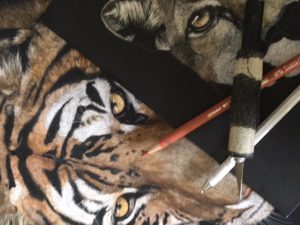 Scratchboard Art is a medium where tools are used by the artist to cut and/or remove an upper dark (often black) layer of ink or paint. Beneath the black layer of ink is a white clay layer. Images are then developed from the exposed white clay board. Hence, the art requires a high level of skill since the artist is utilizing the volume and pattern from the ink removal to produce values within the image. Given the desired pattern extends over an area, the artist must have the required skill to replicate the same hand motion hundreds to thousands of times to produce consistency. After removal, the scratchboard artist then returns to enhance the current black and white image with color. The color may be added via colored pencil, watercolor, and a variety of other paints. Works may be on paper or board.
Scratchboard Art is a medium where tools are used by the artist to cut and/or remove an upper dark (often black) layer of ink or paint. Beneath the black layer of ink is a white clay layer. Images are then developed from the exposed white clay board. Hence, the art requires a high level of skill since the artist is utilizing the volume and pattern from the ink removal to produce values within the image. Given the desired pattern extends over an area, the artist must have the required skill to replicate the same hand motion hundreds to thousands of times to produce consistency. After removal, the scratchboard artist then returns to enhance the current black and white image with color. The color may be added via colored pencil, watercolor, and a variety of other paints. Works may be on paper or board.
Scratchboard was developed in the 19th century in Britain and France. The tools and methods were developed for printing as it produced a fine line that could be photographically reduced for reproduction without losing quality. Because of its commercial roots, scratchboard was not only an artistic style but was the preferred printing technique for medical, scientific and product illustration during the 1930s to the 1950s.
Currently a revival in scratchboard is occurring in recognition of the detail the medium enables the artist to produce. Artists are drawn to the media because of the capability of scratchboard to enable the detail of the subject to be transferred to a “canvas.” Hence, for the artist, scratchboard allows the highest level of detail of any of the other media. As new technologies emerge to further enhance the current method, further growth of this media will occur.




